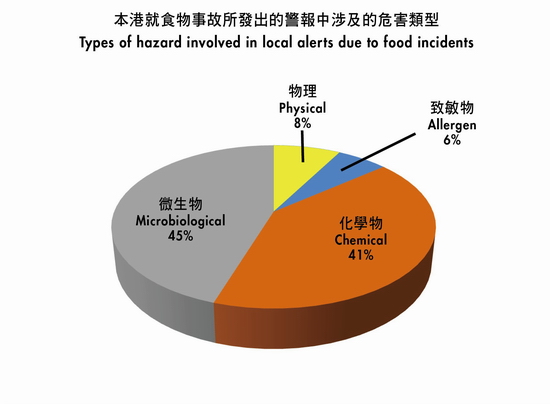
Food Safety Focus ( 115th Issue, February 2016 ) – Incident in Focus
Review of Food Incidents in 2015
Dr. Albert KK Ng, Medical & Health Officer,
Risk Management Section,
Centre for Food Safety
To protect public health, the Centre for Food Safety (CFS) monitors overseas food incidents reported by overseas food authorities and the mass media, assesses their local impact and implements appropriate control measures for those incidents with local relevance and potential public health risk.
Food Incidents in 2015
In 2015, the CFS identified about 1,300 food incidents, and 500 food recalls related to undeclared allergens. The CFS issued 53 press releases, 32 trade alerts and 6 food incident posts on incidents with potential local public health relevance. The hazards identified included chemical (e.g. pesticide residues), microbiological (e.g. Listeria monocytogenes), physical (e.g. foreign body) and undeclared allergens. The breakdown is summarised in the pie chart below. Prompt control measures were implemented immediately.
Three food incidents in 2015 which attracted considerable interest from public and media are highlighted below-
-
Excessive pesticide residues in tea products in Taiwan
In 2015, the Taiwanese authorities announced a number of tea leaf / floral tea samples taken from the Taiwan market were found to have pesticide residue levels exceeding prevailing Taiwanese regulatory standards. To address possible public concern in Hong Kong, apart from communicating with the Taiwanese authorities over the issue, the CFS had also stepped up surveillance on tea leaf and floral tea for pesticide residues immediately. As at the end of 2015, 273 tea leaf and floral tea samples were tested for pesticide residues. All samples were found satisfactory except for a sample of jasmine floral tea which contained triazophos at a level that exceeded Taiwan regulatory standards. Based on the level of triazophos detected in the sample, adverse health effects would not be caused under usual consumption.
The CFS instructed the trade to stop selling the affected products and advised members of the public not to consume affected products.
-
Listeria monocytogenes detected in a smoked salmon sample
In March 2015, in view of Macau's report that a batch of smoked salmon imported from Hong Kong was contaminated with Listeria monocytogenes, the CFS immediately followed up by carrying out a detailed investigation of the case, including site inspection of the food factory and taking samples for testing of Listeria monocytogenes. One smoked salmon sample collected at the factory was found to have Listeria monocytogenes. The CFS instructed the manufacturer concerned to recall all affected batches of its product and to suspend the production line to carry out thorough cleansing and disinfection.
-
Safety concern of food products supplied to Hong Kong after explosions in Tianjin
In August, there was a series of devastating explosions at a chemical storage facility in Tianjin. Fears of environmental pollution by hazardous chemicals (especially cyanides) aroused concerns among the local population and media on the safety of food imported from the Mainland.
Following the occurrence of the incident, the CFS has been maintaining close contact with the Mainland authorities. At that time, according to the Mainland authorities, no vegetables, fruits or live edible aquatic animals from registered farms in Tianjin had been exported to Hong Kong since early 2015. Our records also showed that no live food animal had been imported from Tianjin since the explosion.
To allay public concerns, the CFS has taken samples of food products from areas around Tianjin (e.g. vegetables, fruits and edible aquatic animals) for testing. Our tests did not detect any cyanide in any of the samples taken.
Conclusion
The CFS is committed to protecting food safety by detecting and managing food incidents promptly through risk assessment, risk management and risk communication strategies.


